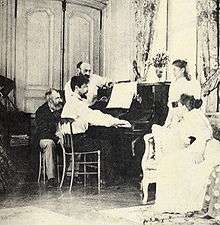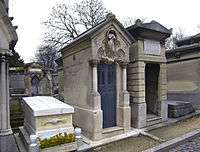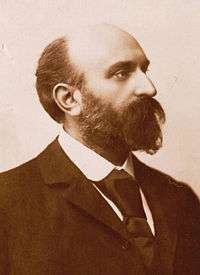Ernest Chausson

Amédée-Ernest Chausson (French: [ʃosɔ̃]; 20 January 1855 – 10 June 1899) was a French romantic composer who died just as his career was beginning to flourish.
Life
Born in Paris into an extremely affluent bourgeois family, Ernest Chausson was the sole surviving child of a building contractor who had made his fortune assisting Baron Haussmann in the redevelopment of Paris in the 1850s. To please his father, Chausson studied law and was appointed a barrister for the Court of Appeals, but had little or no interest in the profession. He frequented the Paris salons, where he met celebrities such as Henri Fantin-Latour, Odilon Redon, and Vincent d'Indy. Before deciding on a musical career, he dabbled in writing and drawing.

In 1879, at the age of 24, he began attending the composition classes of Massenet at the Paris Conservatoire; Massenet came to regard him as 'an exceptional person and a true artist'. Chausson had already composed some piano pieces and songs. Nevertheless, the earliest manuscripts that have been preserved are those corrected by Massenet. At the Paris Conservatoire, Chausson also studied with César Franck, with whom he formed a close friendship that lasted until Franck's death in 1890. Chausson interrupted his studies in 1881, after a failed attempt to win the Prix de Rome. During 1882 and 1883, Chausson, who enjoyed travel, visited Bayreuth to hear the operas of Wagner. On the first of these journeys, Chausson went with d'Indy for the premiere of Wagner's Parsifal, and on the second trip he went with his new spouse Jeanne Escudier (1862-1936), with whom he was to have five children.
From 1886 until his death in 1899, Chausson was secretary of the Société Nationale de Musique. In his own home (22 Boulevard de Courcelles, near Parc Monceau), he received a great many eminent artists, including the composers Henri Duparc, Gabriel Fauré, Claude Debussy, and Isaac Albéniz, the poet Mallarmé, the Russian novelist Turgenev, and the impressionist painter Monet. Chausson also assembled an important collection of paintings.
Death

When only 44 years old, Chausson died while staying at one of his country retreats, the Château de Mioussets, in Limay, Yvelines. Riding his bicycle downhill, Chausson hit a brick wall and died instantly. The exact circumstances remain unclear; although probably a freak accident, there has been the suggestion of suicide, as Chausson was certainly prone to depression. This suicide theory was propounded by Debussy's biographer Edward Lockspeiser,[1] but has been firmly rejected more recently by Chausson's own biographer Ralph Scott Grover.[2]
Chausson was buried in Père Lachaise Cemetery in Paris. His funeral was attended by many leading figures of the arts, including Duparc, Fauré, Albeniz, Redon, Edgar Degas, Auguste Rodin, Henri de Régnier, Pierre Louÿs and Debussy. While Chausson's brotherly relationship with Debussy had ended abruptly five years earlier, following his disapproval of Debussy's promiscuity,[3][4] Debussy never ceased to admire Chausson's music.
Eponymy
A small park, Square Ernest Chausson, in the 17th arrondissement of Paris is named in his honour.
Music

The creative work of Chausson is commonly divided into three periods. In the first, his output was stylistically dominated by Massenet. The second period, dating from 1886, is marked by a more dramatic character, deriving partly from Chausson's contacts with the artistic milieux in which he moved. From his father's death in 1894 dates the beginning of his third period, during which he was especially influenced by his reading of the symbolist poets and Russian literature, particularly Turgenev, Dostoyevsky, and Tolstoy.
Chausson's work is deeply individual, but it does reflect some technical influences of both Wagner and his other musical hero, Franck. Stylistic traces not only of Massenet but also of Brahms can be detected sometimes. In general, Chausson's compositional idiom bridges the gap between the ripe Romanticism of Massenet and Franck and the more introverted Impressionism of Debussy.
Several delicate and admirable songs came from Chausson's pen. He completed one opera, Le roi Arthus (King Arthur). His orchestral output was small, but significant. It includes the symphonic poem Viviane; the Symphony in B-flat, his sole symphony; Poème for violin and orchestra, an important piece in the violin repertoire; and the dramatic, and haunting, song-cycle Poème de l'amour et de la mer.
Chausson is believed to be the first composer to use the celesta. He employed that instrument in December 1888 in his incidental music, written for a small orchestra, for La tempête, a French translation by Maurice Bouchor of Shakespeare's The Tempest.[5]
Not at all prolific, Chausson left behind only 39 opus-numbered pieces. Musical creation for him always proved to be a long, painful struggle. However, the quality and originality of his compositions are consistently high, and several of his works continue to make occasional appearances on programs of leading singers, chamber music ensembles and orchestras.
"There are moments when I feel myself driven by a kind of feverish instinct, as if I had the presentiment of being unable to attain my goal, or of attaining it too late." Ernest Chausson
Notes
- ↑ Edward Lockspeiser, Debussy: His Life and Mind, Vol. 1 (London: Cassell, 1965), p. 126.
- ↑ Ralph Scott Grover, Ernest Chausson: The Man and His Music (London: Athlone Press, 1980), p. 56.; R. J. Stove, César Franck: His Life and Times (Lanham, Maryland: Scarecrow Press, 2012), p. 306.
- ↑ Edward Lockspeiser, Debussy: His Life and Mind, Vol. 1, London: Cassell, 1965, pp 40–47.
- ↑ Nichols, R. (1998) The Life of Debussy. Cambridge University Press, 196 pages.
- ↑ Blades, James and Holland, James. "Celesta"; Gallois, Jean. "Chausson, Ernest: Works," Grove Music Online (Accessed 8 April 2006) (subscription required). Note: The first major composer to use the celesta in a work for full symphony orchestra was Pyotr Tchaikovsky. He first used it in his symphonic poem The Voyevoda in 1891, and the following year in his ballet The Nutcracker, most notably in the "Dance of the Sugarplum Fairy".
References
- Charles Oulmont (1935), Musique de l'amour. I. Ernest Chausson et "la bande à Franck," coll. "Temps et visages" nouvelle série, Desclée de Brouwer et Cie.
- Jean Gallois (1994), Ernest Chausson, Paris: Fayard.
External links
| Wikimedia Commons has media related to Ernest Chausson. |
- Free scores by Ernest Chausson at the International Music Score Library Project
- Free scores by Ernest Chausson in the Choral Public Domain Library (ChoralWiki)
- Hymne védique Chorus accompanied by orchestra, op. 9 Vocal Score (Paris: Hamelle, 1886) From Sibley Music Library Digital Scores Collection
- Mélodies pour chant et piano, op. 2 (Paris: J. Hamelle, 1890) From Sibley Music Library Digital Scores Collection
- Les Vêpres du Commun des saint, op. 31 (Paris: Editions de la Schola Cantorum, 1907) From Sibley Music Library Digital Scores Collection
- Recording of Piano Trio in G minor Op. 3 at the Wayback Machine (archived August 31, 2006)